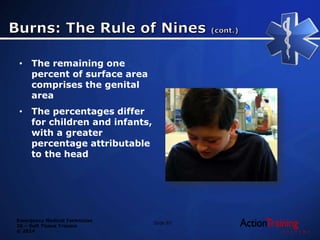The document discusses soft tissue trauma, including closed wounds, open wounds, penetrating injuries, and burn injuries. It describes different types of soft tissue injuries like abrasions, lacerations, avulsions, and crush injuries. For each type of injury, the document outlines how to assess severity and provide initial emergency care, focusing on controlling bleeding, treating for shock, and monitoring vital signs during transport. Special considerations are given to managing amputated body parts. The overall aim is to quickly assess and treat soft tissue injuries based on their nature and severity.

















































































































